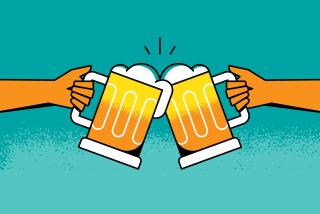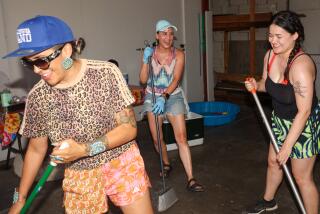A Place That Welcomes the ‘Ghetto Kids’
Being at the Pico Youth and Family Center is sort of like hanging out at a friend’s house--a friend who happens to be the coolest kid in high school.
He’s got a couple of buddies battling for the video game championship on the big screen in the living room. In his bedroom, someone’s installing the latest programs on his computer. And in the basement, thumping bass and scattered rhymes abound as a few friends freestyle and scratch records on his turntables.
This is the dream that Oscar de la Torre had for the youths of the Pico neighborhood in Santa Monica almost four years ago, when a rash of homicides and shootings shocked the otherwise first-rate city. The city set aside more than $300,000 for him and two others to develop a teen center, which was supposed to help curb gang violence, the suspected cause of the fall 1998 shootings.
But that collaboration between the three men whom the city chose to develop the project fell apart, and the original center was never built.
De la Torre, a former Santa Monica High School counselor, did not give up on his goal, though. He stuck it out with the city, and in January opened the Pico Youth and Family Center.
“Out of all that crazy stuff that went down, this is what we envisioned,” De la Torre said.
Just inside the doors at 828 Pico Blvd., three large paintings of cultural heroes hang from the wall symbolizing the center’s mantra. “Promoting peace, unity and social justice,” De la Torre said, standing beneath the watchful eyes of Cesar Chavez, Malcolm X and Rigoberta Menchu, a Mayan from Guatemala who won the 1992 Nobel Peace Prize for her work on behalf of indigenous people’s rights.
The three different perspectives that De la Torre, Manuel Lares and Edward Bell--the collaborators--brought to the initial project were part of the reason for its failure, De la Torre said. Each man envisioned a different program and trying to combine the three visions just didn’t work.
“I’m just glad Oscar has pulled through and made this project happen,” said Lares, who now runs the Santa Monica chapter of Barrios Unidos, a national youth violence-prevention program.
To make the Pico center work, De la Torre sought help from Woodcraft Rangers, an 80-year-old nonprofit agency in Los Angeles that provides academic and recreation services to Los Angeles County youth. The Rangers got a $320,000 grant from Santa Monica and took on the Pico center as a project.
Woodcraft Rangers provide administrative and financial assistance to the Pico center, said Cathie Mostovoy, its chief executive officer. But all the youth services, including job training and placement, are offered in the center.
“Will we stop the violence in the first year? No,” De la Torre said of the center he founded. “We’re one part of the solution. We give young people a voice, to empower young people.”
In the center’s foyer, there’s a round table with chairs where students from UCLA’s Xinachtli program for college-bound youth tutor students in need. Counselors and case managers are on hand for individual and family sessions.
Computers are being hooked up with high-speed digital access so youths can learn Web-page design. De la Torre is in the process of building a video library of Latino and African American cultural films for the 51-inch television screen.
“It’s got to be educational,” De la Torre said. “It’s cool to play video games, but I also want them to learn.”
Equally as important as education, he said, is having youths express what they know the way they know how. That’s why there’s an entire room dedicated to music production and another room with some walls covered with graffiti.
“We’re going to talk to young people through the medium of hip-hop music,” De la Torre said as a few young men tested the studio’s microphones, speakers, keyboard, synthesizer, turntables and mini-disc player.
“It’s about what makes your heart ring, makes your heart sing,” rhymed Dennis Jackson, 24.
Also important in hip-hop culture is graffiti. Three walls in the center are covered with multicolored, oversized, bubbled letters in an effort to “decriminalize” graffiti, De la Torre said, “because this is beautiful; for us, it’s art.” He said he plans to paint over the walls every six months and have new taggers come in to paint.
It’s what he calls “ghetto kids’ expression.” The youths seem to like the center.
“It’s for, like, older kids. Not like the Boys Club or PAL,” said Richard Hernandez, 18, who can’t attend the other clubs at his age. The Pico center is specifically for 16- to 24-year-olds.
Erika Ramirez, 21, a UCLA student who tutors at the center, said she likes it because “it’s not academic solely. It’s trying to develop all aspects of the student in a much more relaxed environment than school.”
Heriberto Gomez Jr., 19, said of the center’s atmosphere: “It’s perfect because it’s something that comes from the streets, the people. So far, it’s been keeping me off the streets.... We’ve been waiting for this [place] for years.”


